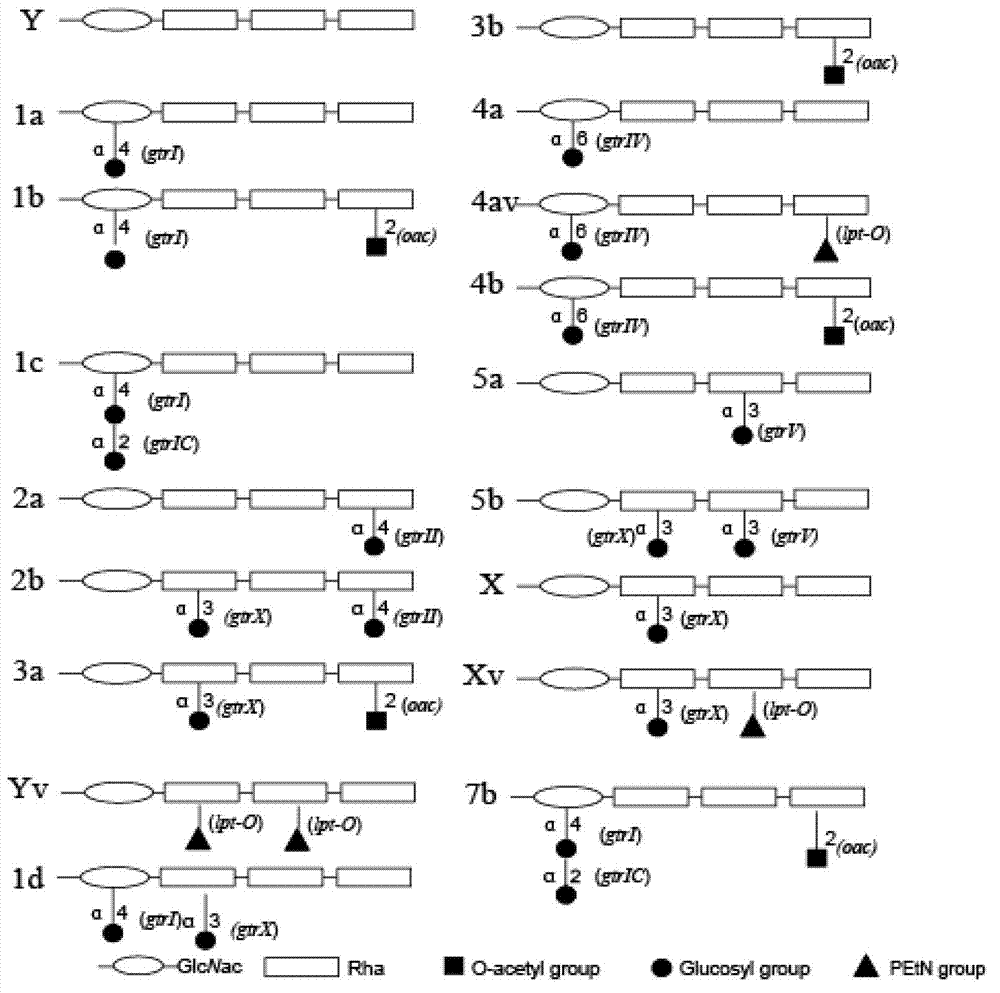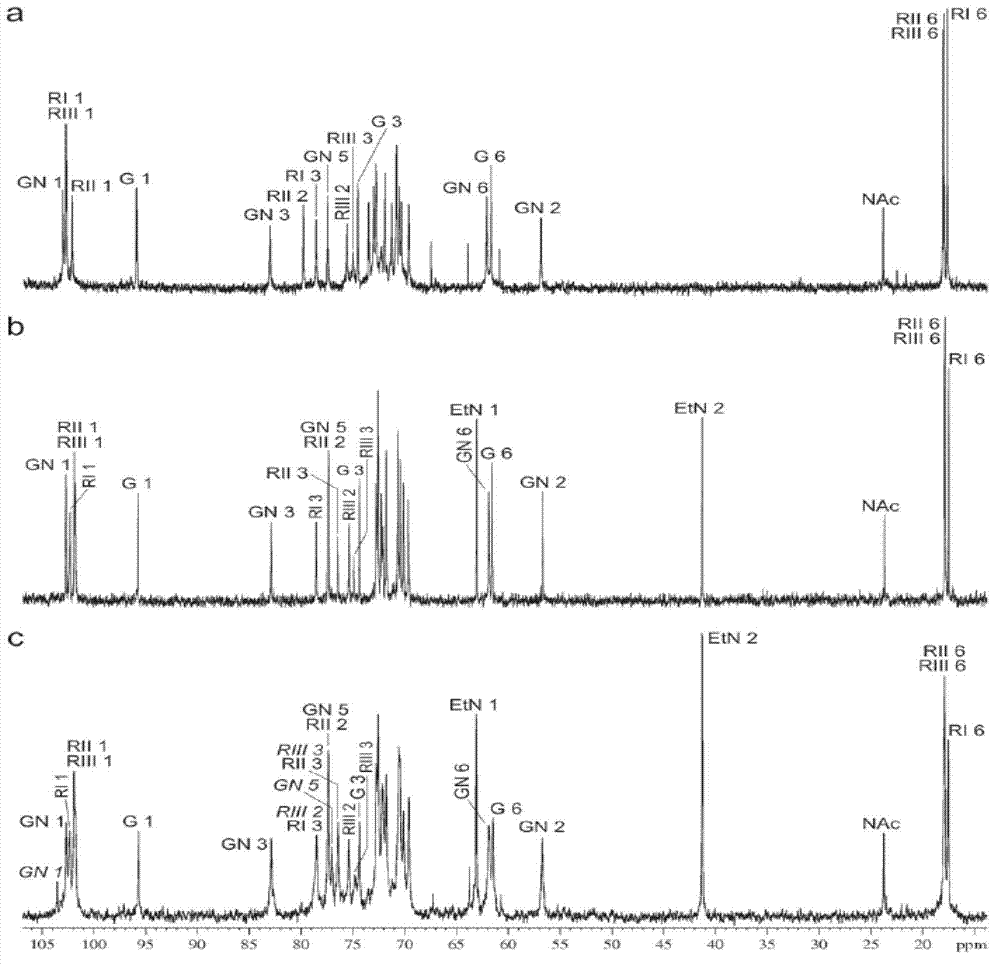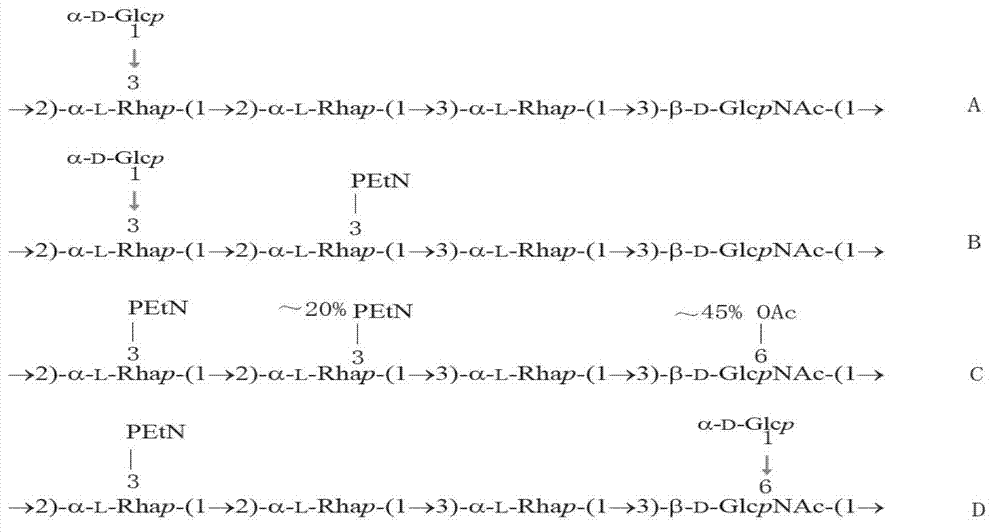Shigella flexneri serotype detection primer, and multiplex amplification using it
A technology for detecting Shigella flexneri and serotypes, applied in the biological field, can solve the problems of inability to distinguish effectively, expensive antiserum reagents, inability to distinguish Xv and X serotypes, etc.
- Summary
- Abstract
- Description
- Claims
- Application Information
AI Technical Summary
Problems solved by technology
Method used
Image
Examples
Embodiment 1
[0048] The determination of the determinant lpt-O gene of embodiment 1, MASF IV-1 antigen and the design of specific detection primer
[0049] In this embodiment, two-dimensional (two-dimensional) 1 H, 1 H and 1 H, 13 C NMR technology (Duus et al., 2000), analyzed the LPS structure of Xv serotype strain 2002017, and its 1 H NMR and 13 C NMR spectrum see figure 2 In b, it has a typical X serotype O antibody structure (Kenne et al., 1977) ( image 3 Middle B), in addition, in the NMR spectrum of Xv bacterial strain, find the signal of a PEtN group (table 3), this PEtN group is added in Rha II ( image 3 Middle B), and this is the same as serotype X ( image 3 The only difference in A). Considering the serotype difference between the two, it can be judged that PEtN modification is the reason for the appearance of MASF IV-1+ phenotype.
[0050] table 3 1 H and 13 C NMR chemical shift s(δ, ppm)
[0051]
[0052]In this example, further through genome comparison, in...
Embodiment 2
[0068] Embodiment 2, Shigella flexneri serotype detection involving multiple amplification primers and multiple amplification
[0069] Materials and methods
[0070] Strains: In this example, 18 known and atypical serotypes (see Table 5) of Shigella flexneri were used for the establishment of multiplex PCR method conditions. A total of 390 Shigella flexneri (Table 6) were used for the evaluation of the validity of the multiplex PCR method of the present invention. To detect the cross-reaction of the primers in this study, 38 strains of different genera (S. Sonnei (n=2), S. dysenteriae (n=12, including all 12 serotypes), S. boydii (n=18, including all 18 serotypes), EHEC (EDL933), E. coli (HB101), E. coli K12 (MG1655), Listeria monocytogenes (54003), etc. Serotypes of all strains of Flexneri Through multivalent antiserum (purchased from Denka Seiken, Japan) and monoclonal antibody (purchased from Reagensia AB, Sweden) verification.All Chinese bacterial strains used in this em...
Embodiment 3
[0092] Embodiment 3, specific detection
[0093] In order to evaluate the specificity of the primers, this example refers to the method described in Example 2, and uses the 9 pairs of primers to perform multiple amplification (wherein the annealing temperature is 55 ° C), and detects 38 non-Fowleria strains, including other Shiga Groups and enteric pathogens. These bacteria amplified negatively (see Figure 13 , Table 8). The specificity of the method of the present invention was proved to be 100%.
[0094] Table 8 is used for the bacterial strain of specificity analysis and PCR amplification result
[0095] Strain / serotype
Number of strains
Specific gene PCR reaction results
S. Sonnie (S)
1
-
S. Sonnie(R)
1
-
S. dysenteriae (1-18)
Each 1
-
S. boydii(1-12)
Each 1
-
EHEC (EDL933)
1
-
UPEC (CFT073)
1
-
Escherichia coli K12 (HB101)
1
-
...
PUM
| Property | Measurement | Unit |
|---|---|---|
| separation | aaaaa | aaaaa |
Abstract
Description
Claims
Application Information
 Login to View More
Login to View More - R&D
- Intellectual Property
- Life Sciences
- Materials
- Tech Scout
- Unparalleled Data Quality
- Higher Quality Content
- 60% Fewer Hallucinations
Browse by: Latest US Patents, China's latest patents, Technical Efficacy Thesaurus, Application Domain, Technology Topic, Popular Technical Reports.
© 2025 PatSnap. All rights reserved.Legal|Privacy policy|Modern Slavery Act Transparency Statement|Sitemap|About US| Contact US: help@patsnap.com



